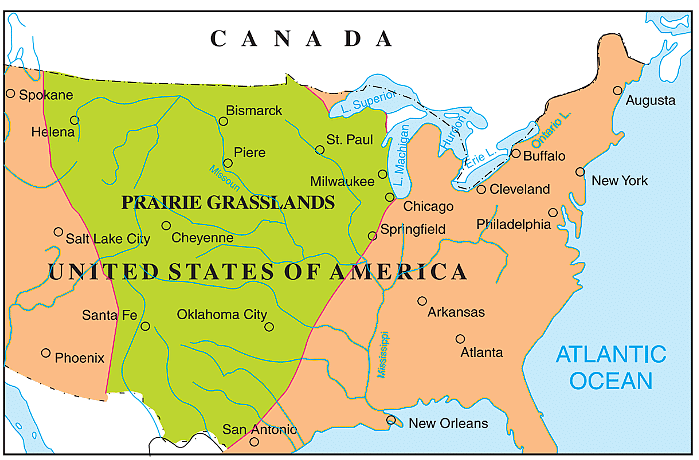The Temperate Grasslands: Prairies Class 5 Notes SST
| Table of contents |

|
| What are The Prairies? |

|
| Major Features of The Prairies |

|
| Living of People Affected by Climatic Conditions |

|
| Economic Importance of The Prairies |

|
What are The Prairies?

- Prairies are large, flat or slightly hilly areas covered mostly by grasses.
- They have a continental climate with:
1. Hot summers
2. Cold winters
3. Moderate rainfall

- The soil in the prairies is very fertile, making it good for growing plants.
- The Prairies support many different plants and animals.
- They are found in places like North America, Eurasia, and Australia.
- These areas lie between 23.5° and 66.5° latitude, in both the northern and southern parts of the Earth.
- The Prairies are also called temperate grasslands because they are found in regions with moderate temperatures.
Major Features of The Prairies
Different Names in Different Places:
- North America: The Prairies
- South America: Pampas
- Eurasia: Steppes
- Australia: Downs
- South Africa: Velds
- East Africa: Savannas
Climate:
- Hot summers and cold winters.
- Rainfall varies:
1. Eastern side: about 100 cm of rain.
2. Western side: around 30 cm of rain.
Plants (Vegetation):
- Three types of grasslands:
1.Tall grass prairies
2. Mixed grass prairies
3.Short grass plains (driest part) - Mostly treeless, but some areas have sand dunes.
Animals (Fauna):
Common animals include:
- Bison, coyotes, prairie dogs, jackrabbits, badgers.
- Birds like hawks, and insects like grasshoppers and flies.
- Some reptiles like rattlesnakes.
Farming (Agriculture):
- The Prairies are important for farming and are called the "Wheat Basket of the World."
- Crops grown include wheat, maize (corn), barley, oats, and cotton.
Mineral Resources:
- Prairies have valuable minerals like coal and mineral oil.
- These are used for mining and making oil products.
Living of People Affected by Climatic Conditions

Climate Variation:
- The Prairies have hot summers and cold winters.
- Rainfall is different:
1. Eastern side: about 100 mm of rain, has tall grasses.
2. Western side: around 30 mm of rain, has thorny grasses. - Because of the harsh weather, fewer people live in prairie regions.
Agriculture:
- The eastern side has very fertile land, great for growing wheat.
- The middle to western parts grow maize (corn), barley, oats, and cotton.
- Farmers use big machines to plant, grow, and harvest crops.
- Wheat is grown in large amounts and sent to other countries.
Livestock Rearing:
- The western prairies are used for raising animals like sheep, cows, and horses.
- Cowboys take care of cattle on ranches, even in tough conditions.
- Some cows are raised for milk and others for meat.
Economic Importance of The Prairies
Economic activities in prairie regions encompass a variety of sectors that contribute to the overall economic growth and development. These activities include:
Farming:
- Agriculture is very important in the prairies.
- Farmers grow crops like wheat, maize (corn), barley, oats, and cotton.
Animal Rearing:
- People in the prairies raise animals like sheep, cows, and horses for different uses.
Meat Processing:
- The meat industry is a big part of the economy.
- They slaughter, process, and package meat for people to buy.
Milk Processing:
- Dairy farming is also common.
- They produce milk, cheese, yoghurt, and butter for everyone to enjoy.
|
33 videos|419 docs|50 tests
|
FAQs on The Temperate Grasslands: Prairies Class 5 Notes SST
| 1. What are the main characteristics of The Prairies? |  |
| 2. How do climatic conditions affect the living of people in The Prairies? |  |
| 3. What economic activities are prominent in The Prairies? |  |
| 4. How do the natural features of The Prairies support biodiversity? |  |
| 5. What challenges do people face living in The Prairies due to climate? |  |















